Schmitt C.B. (ed.) The Cambridge History of Renaissance Philosophy
Подождите немного. Документ загружается.

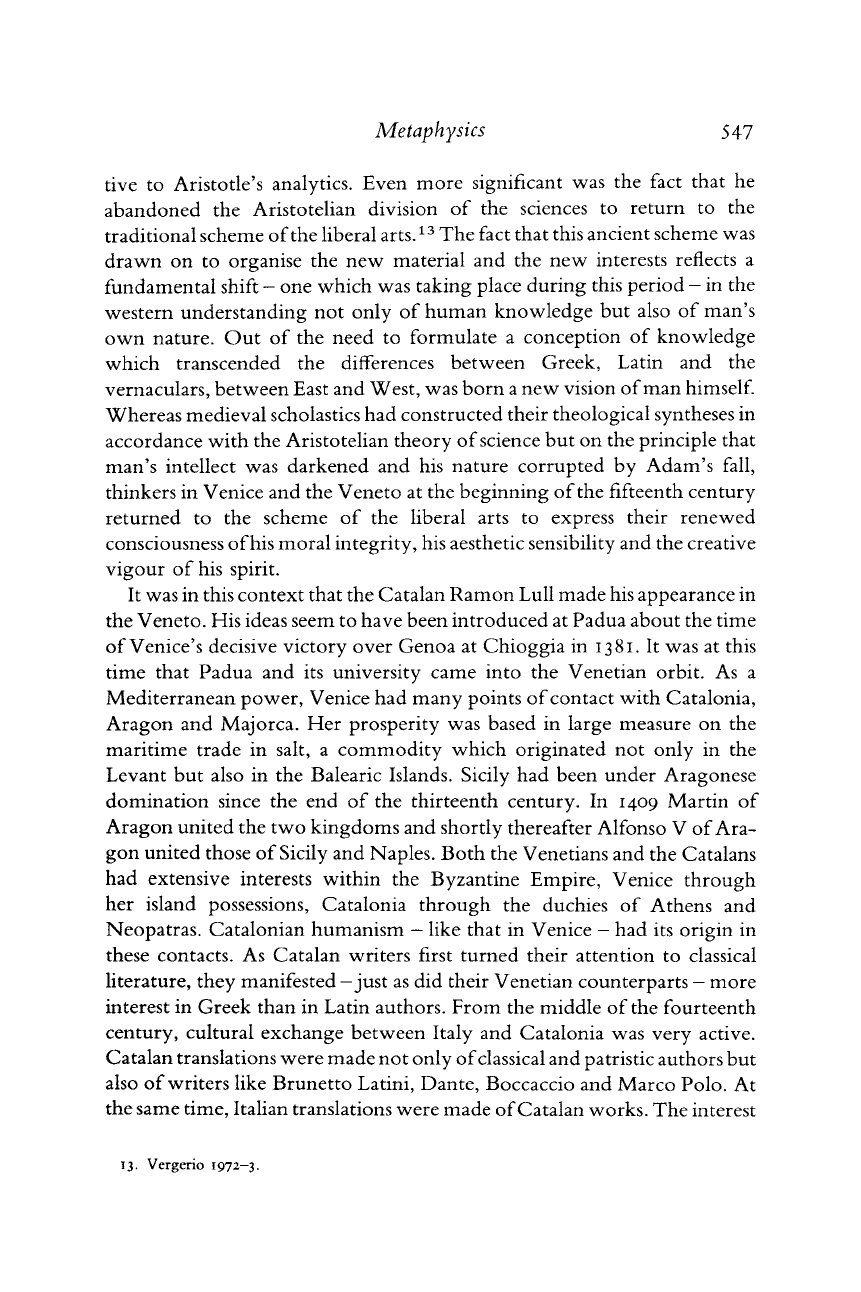
Metaphysics
547
tive
to Aristotle's analytics. Even more significant was the fact
that
he
abandoned the Aristotelian division of the sciences to
return
to the
traditional scheme
of
the liberal arts.
13
The fact
that
this ancient scheme was
drawn on to organise the new material and the new interests reflects a
fundamental shift - one which was taking place during this period - in the
western understanding not only of human knowledge but also of man's
own
nature. Out of the need to formulate a conception of knowledge
which
transcended the differences between Greek, Latin and the
vernaculars, between East and West, was born a new vision
of
man himself.
Whereas medieval scholastics had constructed their theological syntheses in
accordance with the Aristotelian theory of science but on the principle
that
man's intellect was darkened and his
nature
corrupted by Adam's
fall,
thinkers in Venice and the Veneto at the beginning
of
the fifteenth century
returned to the scheme of the liberal
arts
to express their renewed
consciousness
of
his moral integrity, his aesthetic sensibility and the creative
vigour
of his spirit.
It was in this context
that
the Catalan Ramon
Lull
made his appearance in
the Veneto. His ideas seem to have been introduced at Padua about the time
of
Venice's
decisive victory over Genoa at Chioggia in 1381. It was at this
time
that
Padua and its university came into the Venetian orbit. As a
Mediterranean power, Venice had many points of contact with Catalonia,
Aragon
and Majorca. Her prosperity was based in large measure on the
maritime
trade
in salt, a commodity which originated not only in the
Levant
but also in the Balearic Islands.
Sicily
had been under Aragonese
domination since the end of the
thirteenth
century. In 1409 Martin of
Aragon
united the two kingdoms and shortly thereafter Alfonso V
of
Ara-
gon
united those of
Sicily
and Naples. Both the Venetians and the Catalans
had extensive interests within the Byzantine Empire, Venice through
her island possessions, Catalonia through the duchies of Athens and
Neopatras. Catalonian humanism
—
like
that
in Venice
—
had its origin in
these contacts. As Catalan writers first
turned
their attention to classical
literature, they manifested
—
just as did their Venetian counterparts
—
more
interest in Greek
than
in Latin authors. From the middle of the fourteenth
century, cultural exchange between Italy and Catalonia was very active.
Catalan translations were made not only
of
classical
and patristic authors but
also of writers like Brunetto Latini, Dante,
Boccaccio
and Marco Polo. At
the same time, Italian translations were made
of
Catalan works. The interest
13.
Vergerio
1972-3.
Cambridge Histories Online © Cambridge University Press, 2008
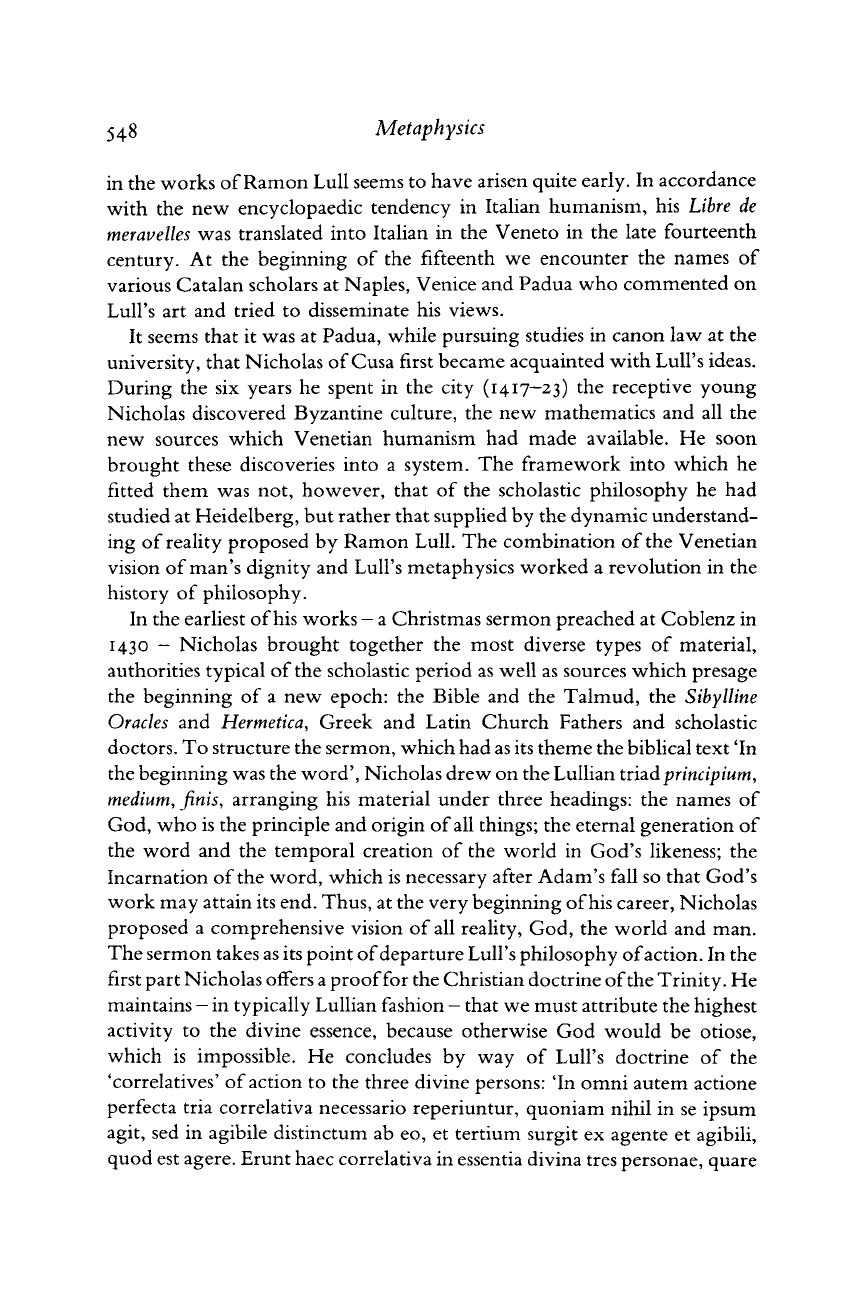
548
Metaphysics
in the works
of
Ramon
Lull
seems to have arisen quite early. In accordance
with
the new encyclopaedic tendency in Italian humanism, his Libre de
meravelles was translated into Italian in the Veneto in the late fourteenth
century. At the beginning of the fifteenth we encounter the names of
various Catalan scholars at Naples, Venice and Padua who commented on
Lull's
art and tried to disseminate his
views.
It seems
that
it was at Padua, while pursuing studies in canon law at the
university,
that
Nicholas
of
Cusa
first became acquainted with Lull's ideas.
During the six years he spent in the city
(1417-23)
the receptive young
Nicholas
discovered Byzantine culture, the new mathematics and all the
new sources which Venetian humanism had made available. He soon
brought these discoveries into a system. The framework into which he
fitted them was not, however,
that
of the scholastic philosophy he had
studied at Heidelberg, but
rather
that
supplied by the dynamic understand-
ing
of reality proposed by Ramon
Lull.
The combination of the Venetian
vision
of man's dignity and Lull's metaphysics worked a revolution in the
history of philosophy.
In the earliest
of
his works
—
a Christmas sermon preached at Coblenz in
1430
- Nicholas brought together the most diverse types of material,
authorities typical of the scholastic period as
well
as sources which presage
the beginning of a new epoch: the Bible and the Talmud, the Sibylline
Oracles
and Hermetica, Greek and Latin Church Fathers and scholastic
doctors. To structure the sermon, which had as its theme the biblical text 'In
the beginning was the word', Nicholas drew on the Lullian triadprincipium,
medium, finis, arranging his material under
three
headings: the names of
God,
who is the principle and origin of all things; the eternal generation of
the word and the temporal creation of the world in God's likeness; the
Incarnation of the word, which is necessary after Adam's
fall
so
that
God's
work
may attain its end. Thus, at the very beginning
of
his career, Nicholas
proposed a comprehensive vision of all reality, God, the world and man.
The
sermon takes as its point
of
departure Lull's philosophy
of
action. In the
first
part
Nicholas offers a
proof for
the Christian doctrine
of
the Trinity. He
maintains
—
in typically Lullian fashion
—
that
we must
attribute
the highest
activity
to the divine essence, because otherwise God would be otiose,
which
is impossible. He concludes by way of Lull's doctrine of the
'correlatives'
of action to the
three
divine persons: 'In omni autem actione
perfecta tria correlativa necessario reperiuntur, quoniam nihil in se ipsum
agit,
sed in agibile distinctum ab eo, et tertium surgit ex agente et agibili,
quod est agere. Erunt haec correlativa in essentia divina
tres
personae, quare
Cambridge Histories Online © Cambridge University Press, 2008
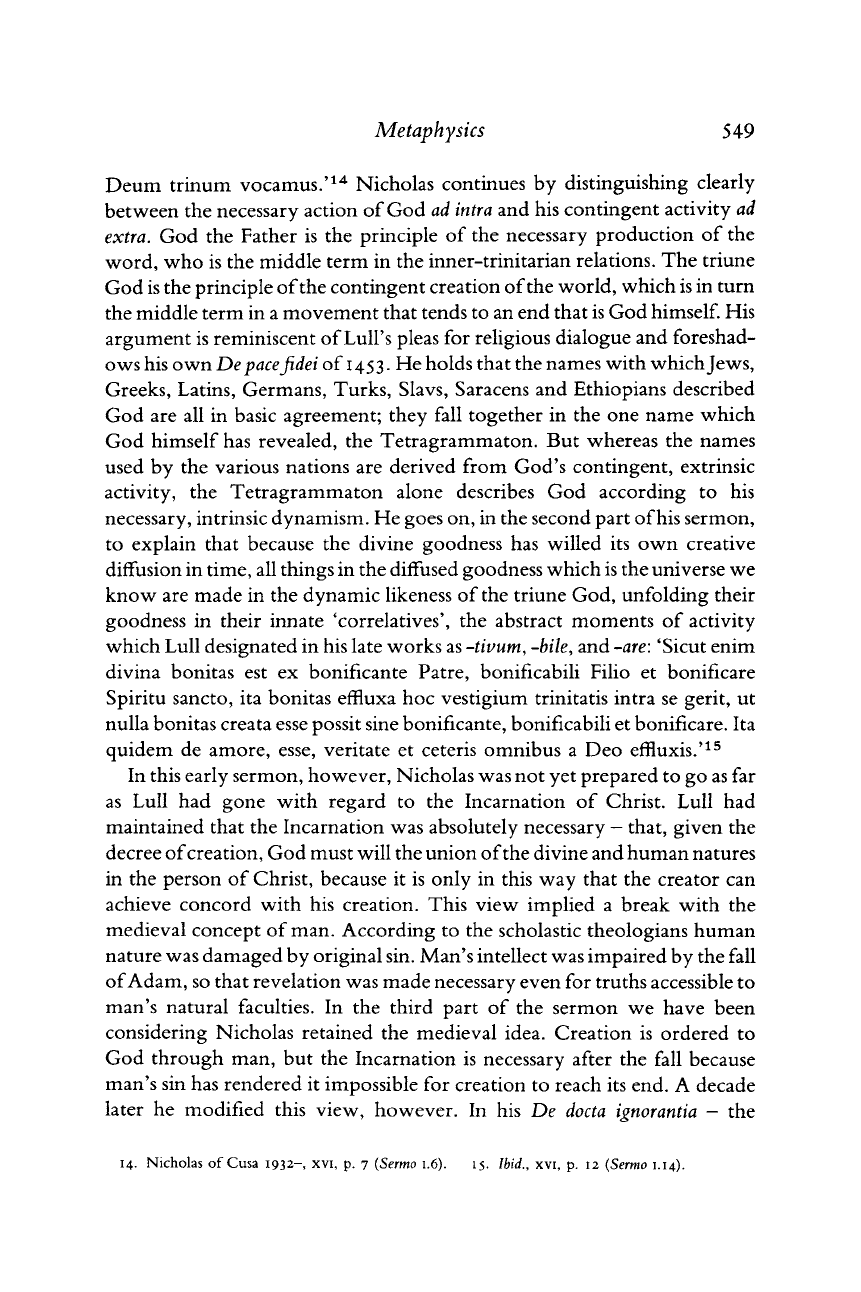
Metaphysics
549
Deum
trinum vocamus.'
14
Nicholas continues by distinguishing clearly
between
the necessary action of God ad intra and his contingent activity ad
extra. God the Father is the principle of the necessary production of the
word,
who is the middle term in the inner-trinitarian relations. The triune
God
is the principle
of
the contingent creation
of
the world, which is in
turn
the middle term in a movement
that
tends to an end
that
is God himself. His
argument is reminiscent
of
Lull's
pleas for religious dialogue and foreshad-
ows
his own Depacefidei of
1453.
He holds
that
the names with
which
Jews,
Greeks,
Latins, Germans, Turks,
Slavs,
Saracens and Ethiopians described
God
are all in basic agreement; they
fall
together in the one name which
God
himself has revealed, the Tetragrammaton. But whereas the names
used by the various nations are derived from God's contingent, extrinsic
activity,
the Tetragrammaton alone describes God according to his
necessary, intrinsic dynamism. He goes on, in the second part
of
his sermon,
to explain
that
because the divine goodness has willed its own creative
diffusion
in time, all things in the diffused goodness which is the universe we
know
are made in the dynamic likeness of the triune God, unfolding their
goodness
in their innate 'correlatives', the abstract moments of activity
which
Lull
designated in his late works as
-tivum,
-bile, and -are: 'Sicut enim
divina
bonitas est ex bonificante Patre, bonificabili Filio et bonificare
Spiritu sancto, ita bonitas effluxa hoc vestigium trinitatis intra se gerit, ut
nulla bonitas creata esse possit sine bonificante, bonificabili et bonificare. Ita
quidem de amore, esse, veritate et ceteris omnibus a Deo
effluxis.'
15
In this early sermon, however, Nicholas was not yet prepared to go as far
as
Lull
had gone with regard to the Incarnation of Christ.
Lull
had
maintained
that
the Incarnation was absolutely necessary
—
that,
given the
decree
of
creation, God must
will
the union
of
the divine and human natures
in the person of Christ, because it is only in this way
that
the creator can
achieve
concord with his creation. This
view
implied a break with the
medieval
concept of man. According to the scholastic theologians human
nature
was damaged by original sin. Man's intellect was impaired by the
fall
of
Adam,
so
that
revelation was made necessary even for
truths
accessible to
man's natural faculties. In the third part of the sermon we have been
considering Nicholas retained the medieval idea. Creation is ordered to
God
through man, but the Incarnation is necessary after the
fall
because
man's sin has rendered it impossible for creation to reach its end. A decade
later he modified this
view,
however. In his De docta ignorantia - the
14.
Nicholas
of Cusa
1932-,
xvi, p. 7 (Sermo 1.6). 15. Ibid., xvi, p. 12 (Sermo 1.14).
Cambridge Histories Online © Cambridge University Press, 2008
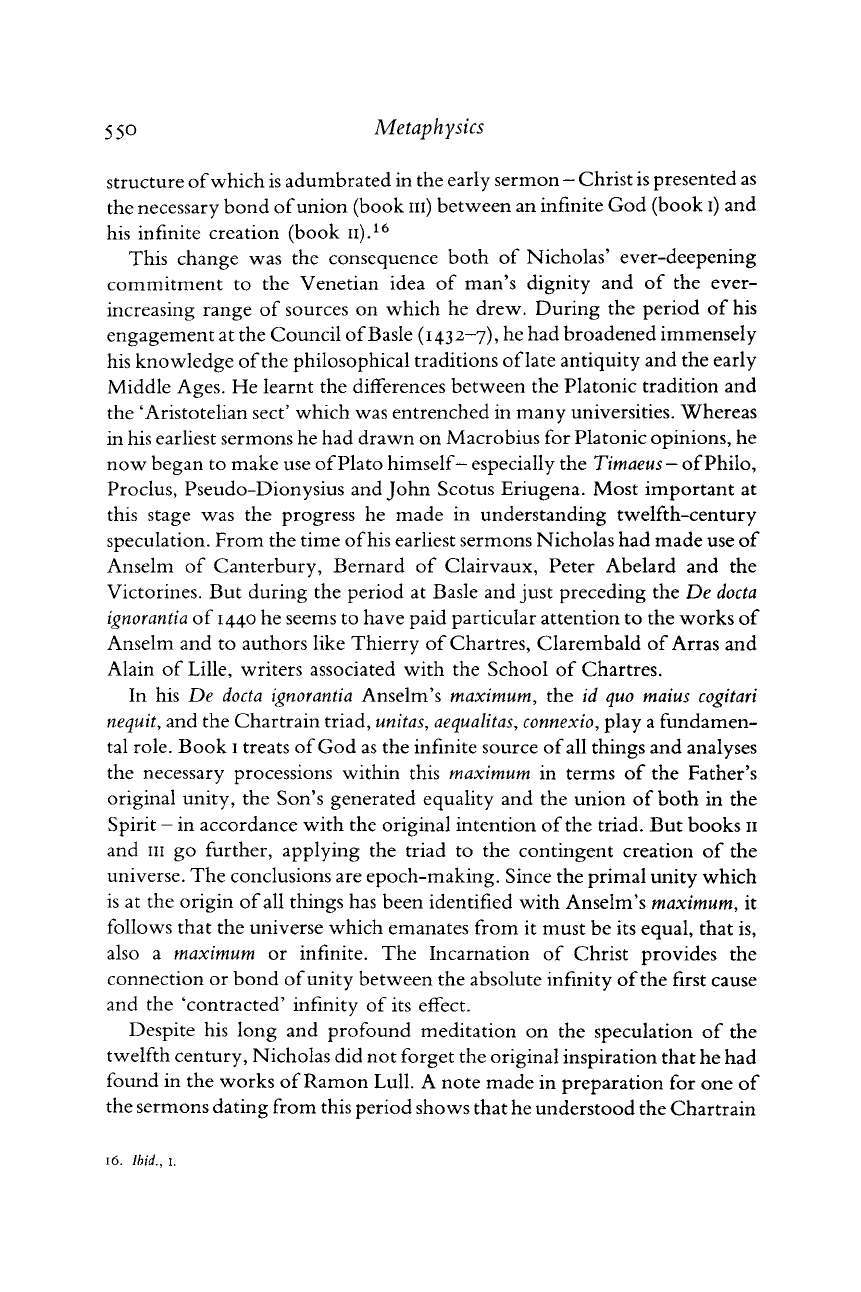
550
Metaphysics
structure
of
which
is adumbrated in the early sermon - Christ is presented as
the necessary bond
of
union (book m) between an infinite God (book i) and
his infinite creation (book n).
16
This
change was the consequence both of Nicholas' ever-deepening
commitment to the Venetian idea of man's dignity and of the ever-
increasing range of sources on which he drew. During the period of his
engagement at the Council
of
Basle
(1432-7),
he had broadened immensely
his knowledge
of
the philosophical traditions
of
late antiquity and the early
Middle
Ages.
He learnt the differences between the Platonic tradition and
the 'Aristotelian sect' which was entrenched in many universities. Whereas
in his earliest sermons he had drawn on Macrobius for Platonic opinions, he
now began to make use
of
Plato
himself
—
especially the Timaeus
—
of
Philo,
Proclus,
Pseudo-Dionysius and
John
Scotus Eriugena. Most important at
this stage was the progress he made in understanding twelfth-century
speculation. From the time
of
his earliest sermons Nicholas had made use of
Anselm
of Canterbury, Bernard of Clairvaux, Peter Abelard and the
Victorines.
But during the period at Basle and just preceding the De docta
ignorantia of 1440 he seems to have paid particular attention to the works of
Anselm
and to authors like Thierry of Chartres, Clarembald of Arras and
Alain
of
Lille,
writers associated with the School of Chartres.
In his De docta ignorantia Anselm's
maximum,
the id quo maius cogitari
nequit, and the Chartrain triad, unitas, aequalitas, connexio, play a fundamen-
tal role.
Book
1
treats
of God as the infinite source
of
all
things and analyses
the necessary processions within this
maximum
in terms of the Father's
original unity, the Son's generated equality and the union of both in the
Spirit
—
in accordance with the original intention of the triad. But books
11
and in go further, applying the triad to the contingent creation of the
universe. The conclusions are epoch-making. Since the primal unity which
is
at the origin of all things has been identified with Anselm's
maximum,
it
follows
that
the universe which emanates from it must be its equal,
that
is,
also a
maximum
or infinite. The Incarnation of Christ provides the
connection or bond
of
unity between the absolute infinity
of
the first cause
and the 'contracted' infinity of its
effect.
Despite his long and profound meditation on the speculation of the
twelfth
century, Nicholas did not forget the original inspiration
that
he had
found in the works of Ramon
Lull.
A note made in preparation for one of
the sermons dating from this period shows
that
he understood the Chartrain
16.
Ibid., 1.
Cambridge Histories Online © Cambridge University Press, 2008
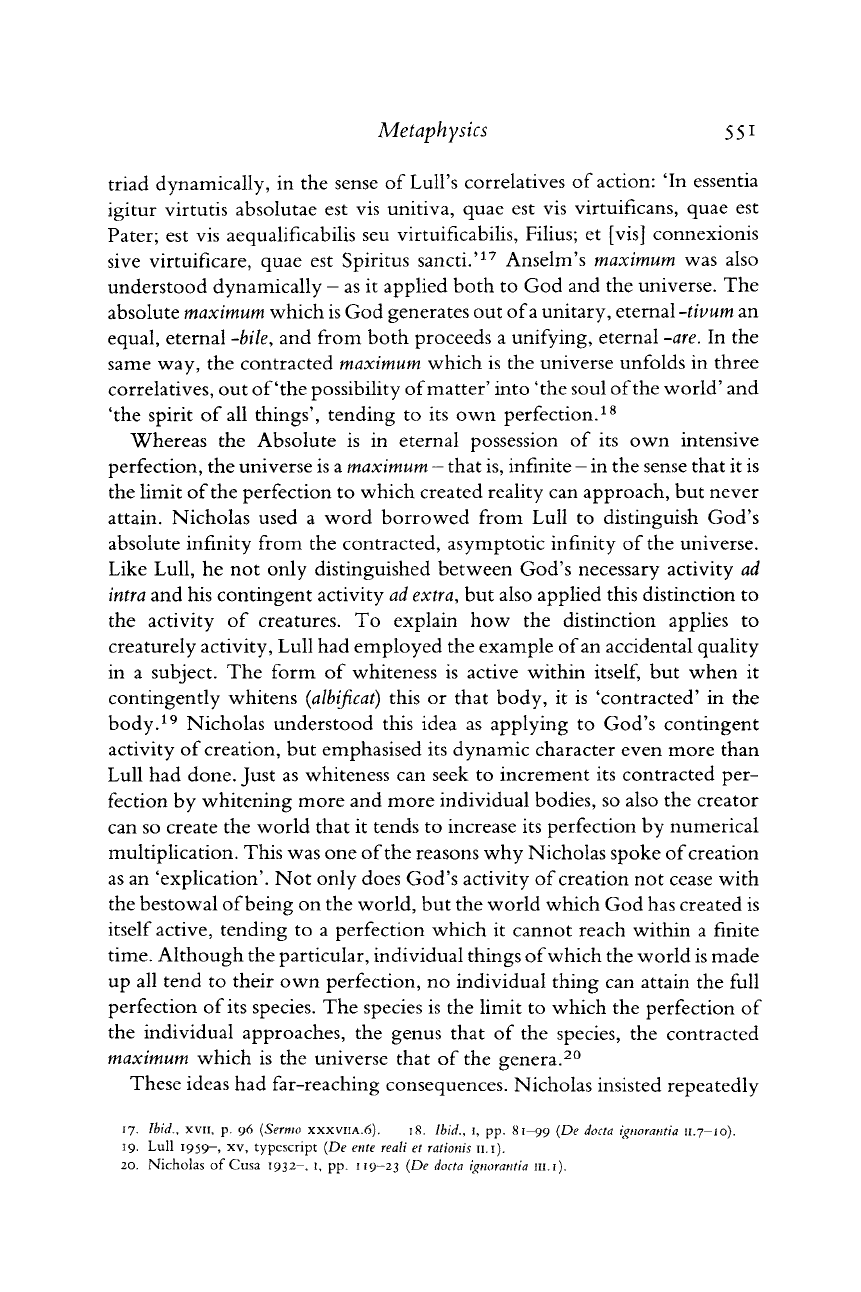
Metaphysics
55i
triad dynamically, in the sense of Lull's correlatives of action: 'In essentia
igitur virtutis absolutae est vis unitiva, quae est vis virtuificans, quae est
Pater; est vis aequalificabilis seu virtuificabilis, Filius; et [vis] connexionis
sive
virtuificare, quae est Spiritus sancti.'
17
Anselm's
maximum
was also
understood dynamically - as it applied both to God and the universe. The
absolute
maximum
which is God generates out
of
a unitary, eternal
-tivum
an
equal, eternal
-bile,
and from both proceeds a unifying, eternal -are. In the
same way, the contracted
maximum
which is the universe unfolds in
three
correlatives,
out of'the possibility
of
matter'
into 'the soul
of
the world' and
'the spirit of all things', tending to its own perfection.
18
Whereas the Absolute is in eternal possession of its own intensive
perfection, the universe is a
maximum
—
that
is, infinite
—
in the sense
that
it is
the limit
of
the perfection to which created reality can approach, but never
attain. Nicholas used a word borrowed from
Lull
to distinguish God's
absolute infinity from the contracted, asymptotic infinity of the universe.
Like
Lull,
he not only distinguished between God's necessary activity ad
intra and his contingent activity ad extra, but also applied this distinction to
the activity of creatures. To explain how the distinction applies to
creaturely activity,
Lull
had employed the example
of
an accidental quality
in a subject. The form of whiteness is active within itself, but when it
contingently whitens (albificat) this or
that
body, it is 'contracted' in the
body.
19
Nicholas understood this idea as applying to God's contingent
activity
of creation, but emphasised its dynamic character even more
than
Lull
had done.
Just
as whiteness can seek to increment its contracted per-
fection
by whitening more and more individual bodies, so also the creator
can so create the world
that
it tends to increase its perfection by numerical
multiplication. This was one
of
the reasons why Nicholas spoke
of
creation
as an 'explication'. Not only does God's activity of creation not cease with
the bestowal
of
being on the world, but the world which God has created is
itself
active, tending to a perfection which it cannot reach within a finite
time. Although the particular, individual things
of
which
the world is made
up all tend to their own perfection, no individual thing can attain the
full
perfection of its species. The species is the limit to which the perfection of
the individual approaches, the genus
that
of the species, the contracted
maximum
which is the universe
that
of the genera.
20
These ideas had far-reaching consequences. Nicholas insisted repeatedly
17.
Ibid.,
xvii,
p. 96 (Sermo
XXXVIIA.6).
18. Ibid., 1, pp. 81-99 (De docta
igtwrantia
11.7-10).
19. Lull 1959- xv,
typescript
(De ente reali et rationis
11.1).
20.
Nicholas
of
Cusa
1932-,
1, pp.
119-23
(De docta
igtwrantia
in. 1).
Cambridge Histories Online © Cambridge University Press, 2008
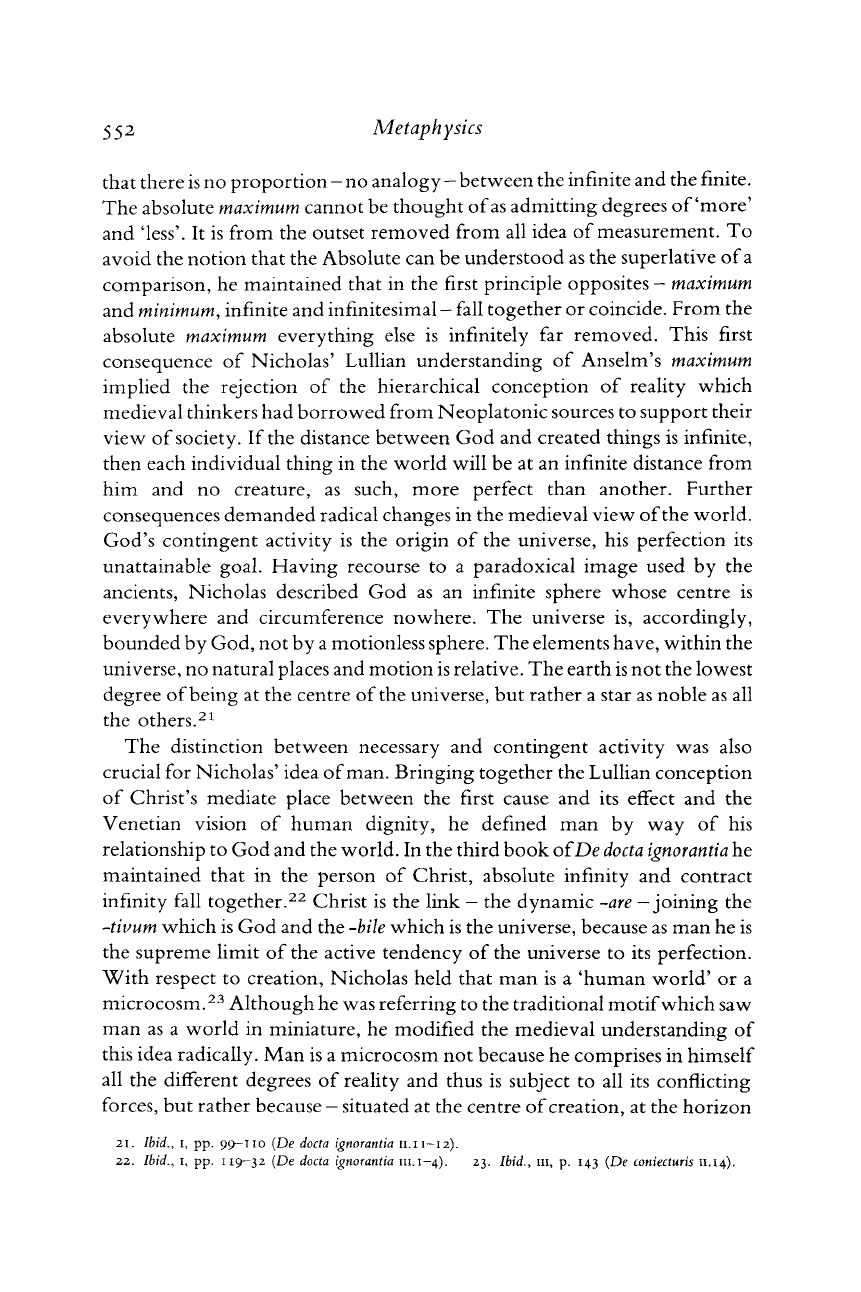
552
Metaphysics
that
there
is no proportion - no analogy - between the infinite and the finite.
The
absolute
maximum
cannot be thought
of
as admitting degrees of'more'
and 'less'. It is from the outset removed from all idea of measurement. To
avoid
the notion
that
the Absolute can be understood as the superlative
of
a
comparison, he maintained
that
in the first principle opposites -
maximum
and
minimum,
infinite and infinitesimal -
fall
together or coincide. From the
absolute
maximum
everything else is infinitely far removed. This first
consequence of Nicholas' Lullian understanding of Anselm's
maximum
implied the rejection of the hierarchical conception of reality which
medieval
thinkers had borrowed from Neoplatonic sources to support their
view
of society. If the distance between God and created things is infinite,
then each individual thing in the world
will
be at an infinite distance from
him and no creature, as such, more perfect
than
another. Further
consequences demanded radical changes in the medieval
view
of
the world.
God's
contingent activity is the origin of the universe, his perfection its
unattainable
goal.
Having recourse to a paradoxical image used by the
ancients, Nicholas described God as an infinite sphere whose centre is
everywhere
and circumference nowhere. The universe is, accordingly,
bounded by God, not by a motionless sphere. The elements have, within the
universe, no natural places and motion is relative. The earth is not the lowest
degree
of
being at the centre of the universe, but
rather
a
star
as noble as all
the others.
21
The
distinction between necessary and contingent activity was also
crucial
for Nicholas' idea
of
man. Bringing together the Lullian conception
of
Christ's mediate place between the first cause and its
effect
and the
Venetian
vision of human dignity, he defined man by way of his
relationship to God and the world. In the
third
book
of
De
docta ignorantia he
maintained
that
in the person of Christ, absolute infinity and contract
infinity
fall
together.
22
Christ is the link
—
the dynamic -are
—
joining the
-tivum
which is God and the -bile which is the universe, because as man he is
the supreme limit of the active tendency of the universe to its perfection.
With
respect to creation, Nicholas held
that
man is a 'human world' or a
microcosm.
23
Although he was referring to the traditional
motif
which
saw
man as a world in miniature, he modified the medieval understanding of
this idea radically. Man is a microcosm not because he comprises in himself
all
the different degrees of reality and
thus
is subject to all its conflicting
forces,
but
rather
because
—
situated at the centre
of
creation, at the horizon
21. Ibid., i, pp.
99—110
(De docta ignorantia
11.11—12).
22. Ibid., 1, pp.
119-32
(De docta ignorantia
m.1-4).
23. Ibid., m, p. 143 (De coniecturis 11.14).
Cambridge Histories Online © Cambridge University Press, 2008

Metaphysics
553
of
time and eternity - he unites in himself the lowest
level
of intellectual
reality and the highest reach of sensible
nature
and is thus a bond which
holds creation together.
24
With
respect to the creator, man is a 'human god' or a 'second god',
25
because of the creative power of his mind.
Just
as God is active ad extra,
creating real things and natural forms, so also man can bring forth rational
things and artificial forms
—
mathematical ideas, instruments and tools and
works
of art. The mathematical sciences have their origin in man's mind,
just as real beings have theirs in the divine intellect. In producing tools and
works
of art, man uses materials he finds in nature, but the forms he
gives
them are not mere imitations
of
natural things. They are
true
productions of
his own mind. Man's creative power thus approaches
that
of God, but
whereas God brings forth what he understands, man is able only to
understand what God has brought forth. His mind does not
—
like
that
of
God
—
produce real beings, but can only represent them and appropriate
them to itself.
26
The
metaphysical distinction between necessary activity ad intra and
contingent activity ad extra was important for Nicholas' understanding of
man's dignity because it enabled him to analyse more profoundly the
nature
of human knowledge.
Lull
had maintained
that
things like fire and
whiteness have their own necessary, proper and intrinsic correlatives of
action, whereas their objects ad extra (earth or water, this or
that
body) are
contingent and appropriated to them. Nicholas drew the consequences of
this idea for human knowledge. The sensible things which the mind
encounters in the world are not necessary objects of
knowledge.
Even the
things which the mind
itself
produces
—
a geometrical theorem or the form
of
a spoon
—
are objects appropriated by the mind to itself. The proper
object
of
the mind must be an interior reality.
Just
as the proper object
of
fire
is
not earth or water but rather fire itself as ignitable, so also the proper
object
of the mind can only be the mind itself as knowable. To discover its
true
self, the mind must withdraw from the otherness which is involved in
sense-perception and rational knowledge and
turn
inward. It must
turn
away
from its contingent activity ad extra and ascend to its own necessary,
intrinsic dynamism. The condition of the mind's
return
to itself
is
a delib-
erate, prior choice. Man's ultimate autonomy is grounded not only in his
faculties
of knowledge, but also in his ability freely to choose. Through
his faculties of knowledge man can comprehend all things; through his
24. Ibid., XII, p. 91 (De venatione sapientiae 32). 25. Ibid., m, p. 143 (De coniecturis 11.14).
26. Ibid., m, pp. 126-9 (De coniecturis 11.12); ibid., v (1983 edn), pp. 92-112 (Idiota de mente 2-3).
Cambridge Histories Online © Cambridge University Press, 2008
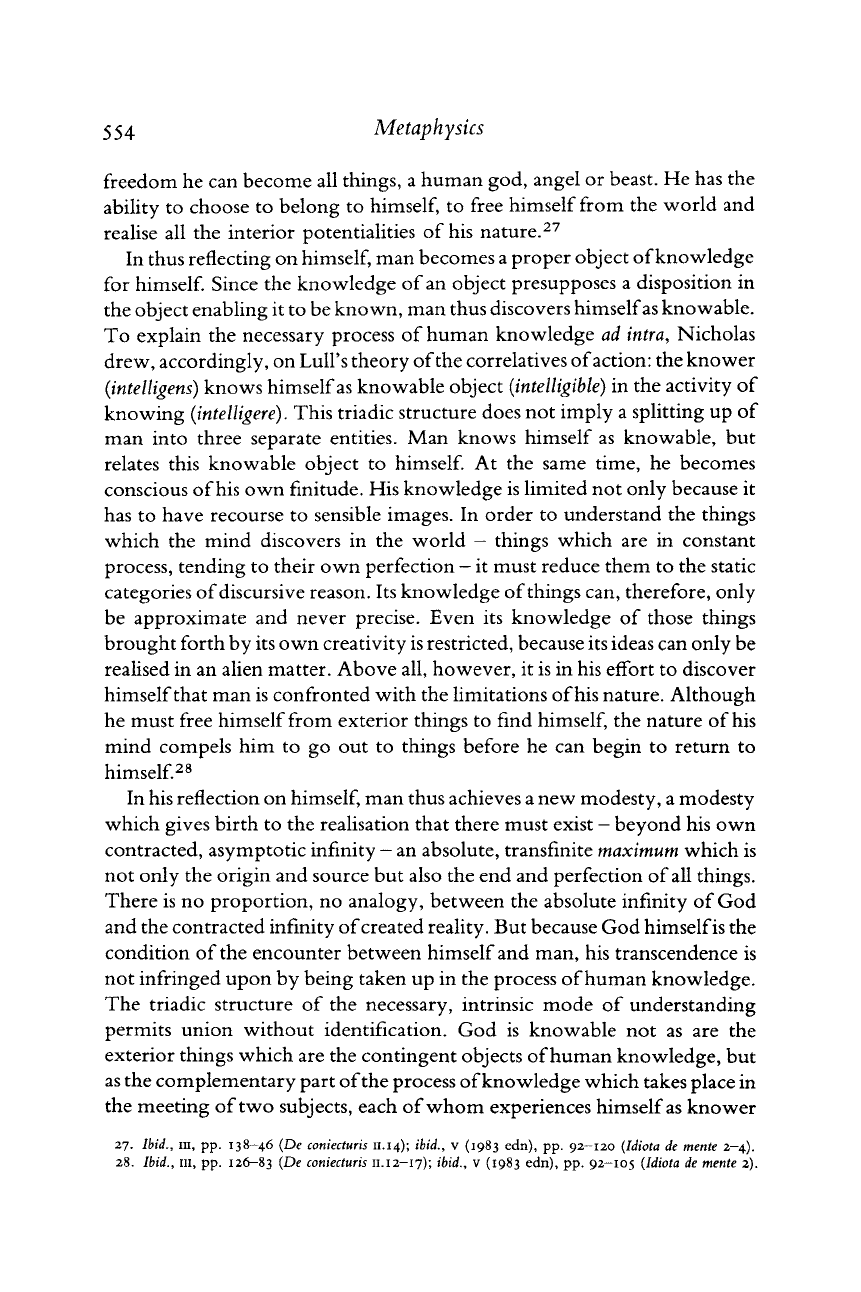
554
Metaphysics
freedom
he can
become
all
things,
a
human god, angel
or
beast.
He has the
ability
to
choose
to
belong
to
himself,
to
free himself from
the
world
and
realise
all the
interior potentialities
of his
nature.
27
In
thus
reflecting
on
himself,
man
becomes
a
proper object
of
knowledge
for
himself. Since
the
knowledge
of an
object presupposes
a
disposition
in
the object enabling
it to be
known,
man
thus
discovers
himself
as knowable.
To
explain
the
necessary process
of
human knowledge
ad
intra, Nicholas
drew, accordingly,
on
Lull's theory
of
the correlatives
of
action:
the
knower
(intelligens) knows
himself
as knowable object (intelligible)
in the
activity
of
knowing
(intelligere). This triadic structure does
not
imply
a
splitting
up of
man into
three
separate entities.
Man
knows himself
as
knowable,
but
relates this knowable object
to
himself.
At the
same time,
he
becomes
conscious
of
his
own
finitude.
His
knowledge
is
limited
not
only because
it
has
to
have recourse
to
sensible images.
In
order
to
understand
the
things
which
the
mind discovers
in the
world
—
things which
are in
constant
process, tending
to
their
own
perfection
—
it
must reduce them
to the
static
categories
of
discursive reason.
Its
knowledge
of
things can, therefore, only
be approximate
and
never precise. Even
its
knowledge
of
those things
brought forth
by its own
creativity is restricted, because
its
ideas
can
only
be
realised
in an
alien
matter.
Above
all, however,
it is in his
effort
to
discover
himself
that
man is
confronted with
the
limitations
of
his nature. Although
he must free himself from exterior things
to
find himself,
the
nature
of
his
mind compels
him to go out to
things before
he can
begin
to
return
to
himself.
28
In
his
reflection
on
himself,
man
thus
achieves
a new
modesty,
a
modesty
which
gives
birth
to the
realisation
that
there
must exist
—
beyond
his own
contracted, asymptotic infinity
—
an
absolute, transfinite
maximum
which
is
not only
the
origin
and
source
but
also
the end and
perfection
of
all
things.
There
is no
proportion,
no
analogy, between
the
absolute infinity
of
God
and
the
contracted infinity
of
created reality.
But
because God
himself
is
the
condition
of the
encounter between himself
and man, his
transcendence
is
not infringed upon
by
being taken
up in the
process
of
human knowledge.
The
triadic structure
of the
necessary, intrinsic mode
of
understanding
permits union without identification.
God is
knowable
not as are the
exterior things which
are the
contingent objects
of
human knowledge,
but
as
the
complementary
part
of
the process
of
knowledge
which takes place
in
the meeting
of
two subjects, each
of
whom experiences
himself
as knower
27. Ibid.,
in, pp. 138-46 (De
coniecturis 11.14); ibid.,
v (1983 edn), pp. 92-120
(Idiota
de
mente
2-4).
28.
Ibid.,
in, pp. 126-83 (-De
coniecturis 11.12-17); ibid.,
v (1983 edn), pp. 92-105
(Idiota
de
mente
2).
Cambridge Histories Online © Cambridge University Press, 2008
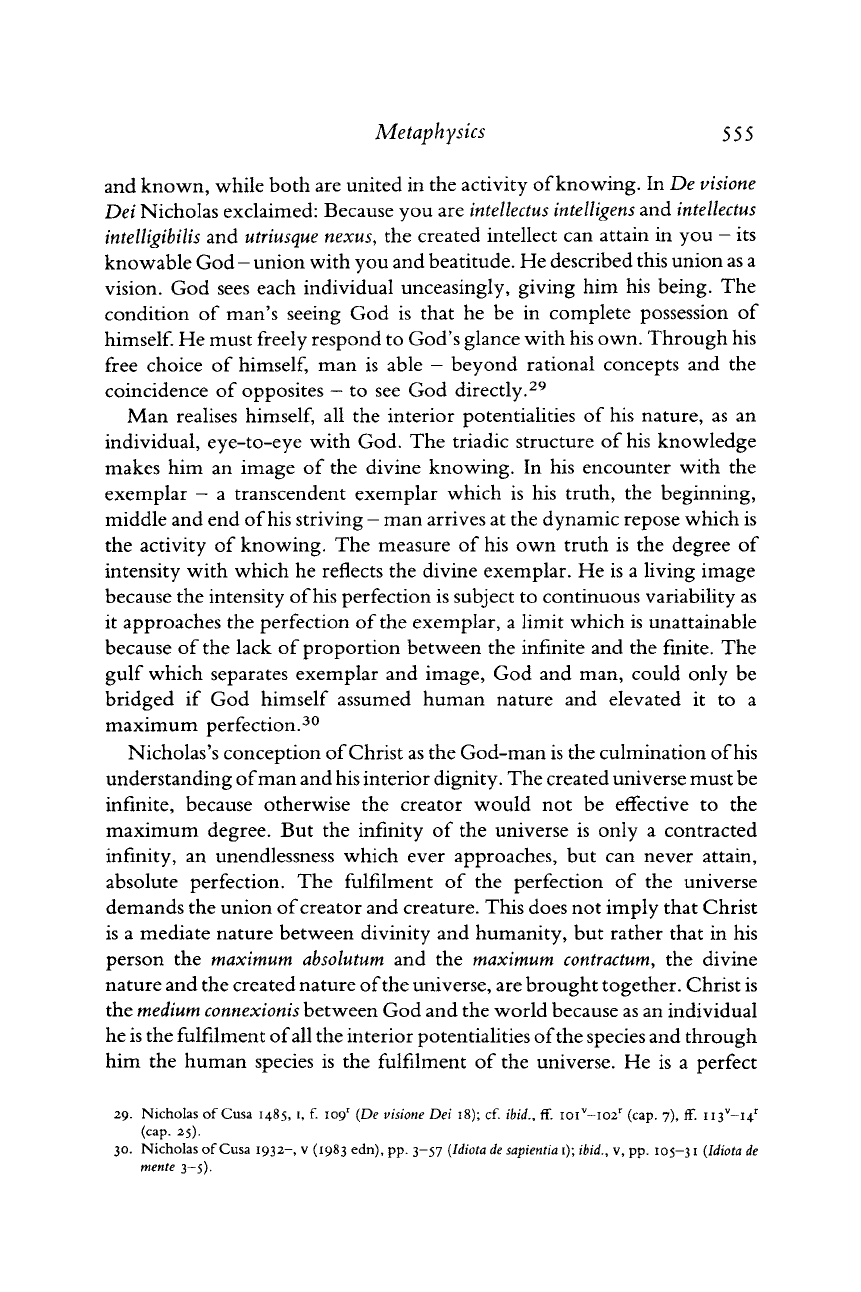
Metaphysics
555
and known, while both are united in the activity
of
knowing.
In De visione
Dei
Nicholas exclaimed: Because you are intellectus intelligens and intellectus
intelligibilis and utriusque nexus, the created intellect can attain in you - its
knowable
God - union with you and beatitude. He described this union as a
vision.
God sees each individual unceasingly,
giving
him his being. The
condition of man's seeing God is
that
he be in complete possession of
himself. He must freely respond to God's glance with his own. Through his
free choice of himself, man is able — beyond rational concepts and the
coincidence of opposites
—
to see God directly.
29
Man realises himself, all the interior potentialities of his nature, as an
individual, eye-to-eye with God. The triadic structure of his knowledge
makes him an image of the divine knowing. In his encounter with the
exemplar
—
a transcendent exemplar which is his
truth,
the beginning,
middle and end
of
his striving
—
man arrives at the dynamic repose which is
the activity of knowing. The measure of his own
truth
is the degree of
intensity with which he reflects the divine exemplar. He is a
living
image
because the intensity
of
his perfection is subject to continuous variability as
it approaches the perfection of the exemplar, a limit which is unattainable
because of the lack of proportion between the infinite and the finite. The
gulf
which separates exemplar and image, God and man, could only be
bridged if God himself assumed human
nature
and elevated it to a
maximum perfection.
30
Nicholas's
conception
of
Christ as the God-man is the culmination
of
his
understanding
of
man and his interior dignity. The created universe must be
infinite, because otherwise the creator would not be
effective
to the
maximum degree. But the infinity of the universe is only a contracted
infinity, an unendlessness which ever approaches, but can never attain,
absolute perfection. The fulfilment of the perfection of the universe
demands the union
of
creator and creature. This does not imply
that
Christ
is
a mediate
nature
between divinity and humanity, but
rather
that
in his
person the
maximum
absolutum and the
maximum
contractum, the divine
nature
and the created
nature
of
the universe, are brought together. Christ is
the
medium
connexionis between God and the world because as an individual
he is the fulfilment
of
all
the interior potentialities
of
the species and through
him the human species is the fulfilment of the universe. He is a perfect
29.
Nicholas
of
Cusa
1485, 1, f.
I09
r
(De visione Dei 18); cf. ibid., ff.
ioi
v
-i02
r
(cap. 7), ff.
H3
v
-i4
r
(cap. 25).
30.
Nicholas
of
Cusa
1932-,
v (1983 edn), pp. 3-57 (Idiota de sapientia 1); ibid., v, pp.
105-31
(Idiota de
mente
3-5).
Cambridge Histories Online © Cambridge University Press, 2008
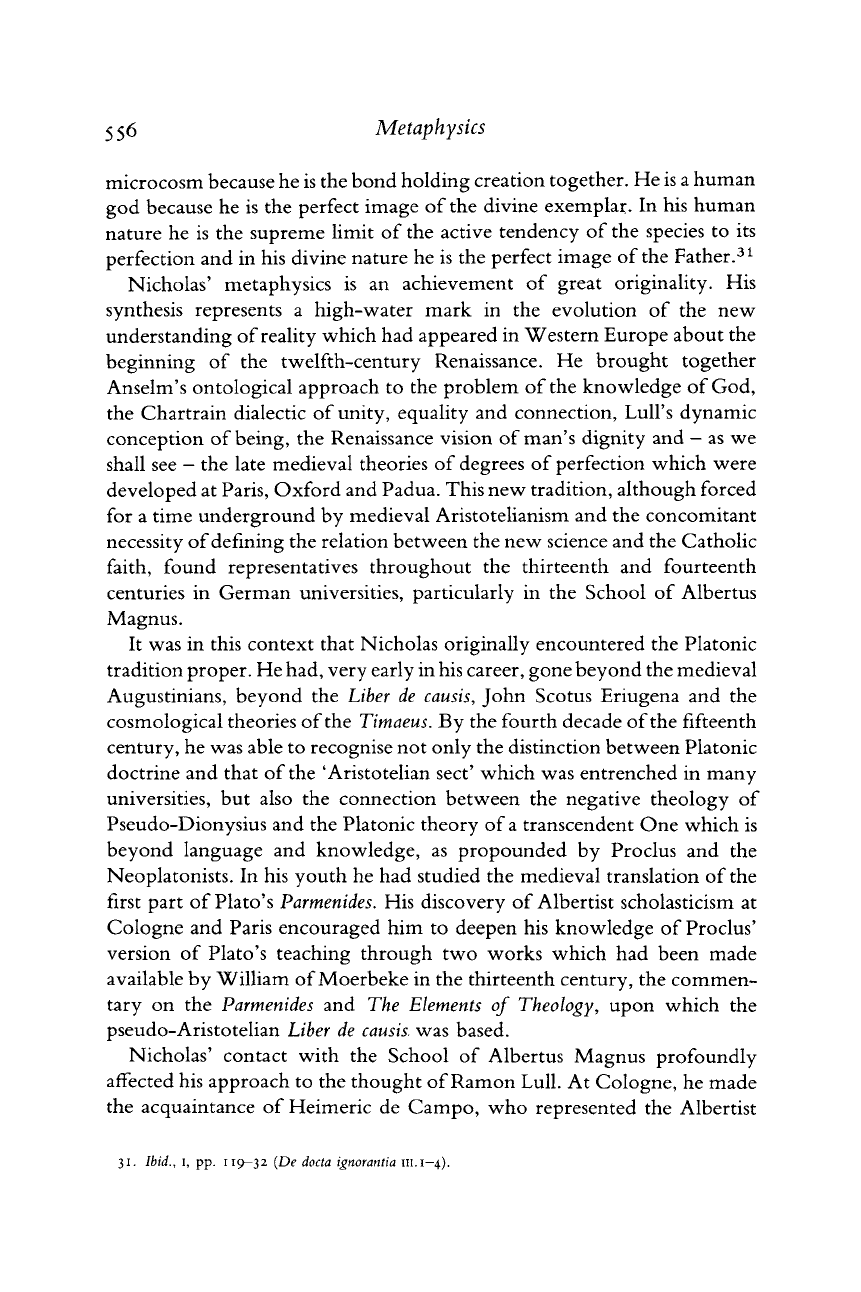
556
Metaphysics
microcosm because he is the bond holding creation together. He is a human
god
because he is the perfect image of the divine exemplar. In his human
nature
he is the supreme limit of the active tendency of the species to its
perfection and in his divine
nature
he is the perfect image of the Father.
31
Nicholas'
metaphysics is an achievement of great originality. His
synthesis represents a high-water mark in the evolution of the new
understanding of reality which had appeared in Western Europe about the
beginning of the twelfth-century Renaissance. He brought together
Anselm's
ontological approach to the problem of the knowledge of God,
the Chartrain dialectic of unity, equality and connection, Lull's dynamic
conception of being, the Renaissance vision of man's dignity and
—
as we
shall see
—
the late medieval theories of degrees of perfection which were
developed
at Paris, Oxford and Padua. This new tradition, although forced
for
a time underground by medieval Aristotelianism and the concomitant
necessity
of
defining the relation between the new science and the Catholic
faith, found representatives throughout the
thirteenth
and fourteenth
centuries in German universities, particularly in the School of Albertus
Magnus.
It was in this context
that
Nicholas originally encountered the Platonic
tradition proper. He had, very early in his career, gone beyond the medieval
Augustinians, beyond the Liber de causis,
John
Scotus Eriugena and the
cosmological
theories
of
the Timaeus. By the fourth decade
of
the fifteenth
century, he was able to recognise not only the distinction between Platonic
doctrine and
that
of the 'Aristotelian sect' which was entrenched in many
universities, but also the connection between the negative theology of
Pseudo-Dionysius and the Platonic theory of a transcendent One which is
beyond language and knowledge, as propounded by Proclus and the
Neoplatonists. In his youth he had studied the medieval translation of the
first
part
of Plato's Parmenides. His discovery of Albertist scholasticism at
Cologne
and Paris encouraged him to deepen his knowledge of Proclus'
version of Plato's teaching through two works which had been made
available
by William
of
Moerbeke in the
thirteenth
century, the commen-
tary on the Parmenides and The Elements of Theology, upon which the
pseudo-Aristotelian Liber de causis was based.
Nicholas'
contact with the School of Albertus Magnus profoundly
affected
his approach to the thought of Ramon
Lull.
At
Cologne,
he made
the acquaintance of Heimeric de Campo, who represented the Albertist
31. Ibid., 1, pp.
119-32
(De docta
ignorantia
m.1-4).
Cambridge Histories Online © Cambridge University Press, 2008
